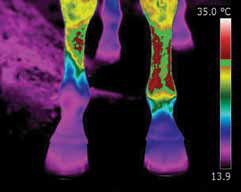
-
Application Stories
• Building
• Furnace and Boiler Tube Inspection
• Medical
Thermal imaging helps Olympic riders and their horses win medals
FLIR cameras help spot clinical problems in horses early on, preventing serious injury
In equestrian sports like horse racing, show-jumping, dressage and polo, the horse is at least as much the athlete as the rider. Perhaps even more so, for the horse is the one that mostly takes care of the physical exertion. Just like any other athlete, horses can get injured, but FLIR thermal cameras help to keep the horses healthy and ready to perform at the peak of their ability.
"Thermal imaging is a wonderful tool to spot an injury before there are any visible signs", says Sandie Chambers, director of training and development for Equitherm, a company that specializes in equine thermal imaging. "In fact, with thermal imaging you can sometimes see injuries two or three weeks before any physical signs and symptoms are visibly apparent."
Sandie has studied both human and equine sports science and has been the driving force behind Equitherm. Having spent almost her entire career in Equine sports and being a seasoned Equestrian herself, she immediately realized the importance of thermal imaging for the equine sports industry. "When I discovered how effective thermal imaging was in identifying trauma and stress in the horse, it was like finding gold." Equine thermal imaging is a non-invasive diagnostic tool that uses thermal imaging equipment and computer software to detect minute differences in the horse's thermal and neural condition. "It allows us to quickly and efficiently identify trauma in an injured animal. By identifying the location of the injury we can prevent further damage." Sandie and her colleagues at Equitherm use the FLIR B335 series thermal cameras to scan the entire horse's body for hot or cold spots. A hot spot indicates inflammation or increased blood flow. Cold spots indicate a decreased blood flow, usually the result of swelling, nerve damage or scar tissue.


In a routine thermography checkup (left) Sandie discovered a severe injury. There is an obvious difference in the thermal pattern between the left and right front leg. On the right is the injured leg in close-up. There is a very clear hot spot indicating some kind of injury in the tendon.
- Home
- |
- Products
- |
- Training
- |
- Application |
- Image Gallery |
- Contact Us
Copyright ©2012 - Thermoscan Co., Ltd. - All Rights Reserved.
Thermoscan Co., Ltd. (บริษัท เทอร์โมสแกน จำกัด)
731 PM Tower, 5th Floor, Asok Dindaeng Road, Dindaeng, Dindaeng, Bangkok 10400
Tel: (02) 642-9489 Fax: (02) 642-9424
E-mail: tms@thermoscan.co.th
